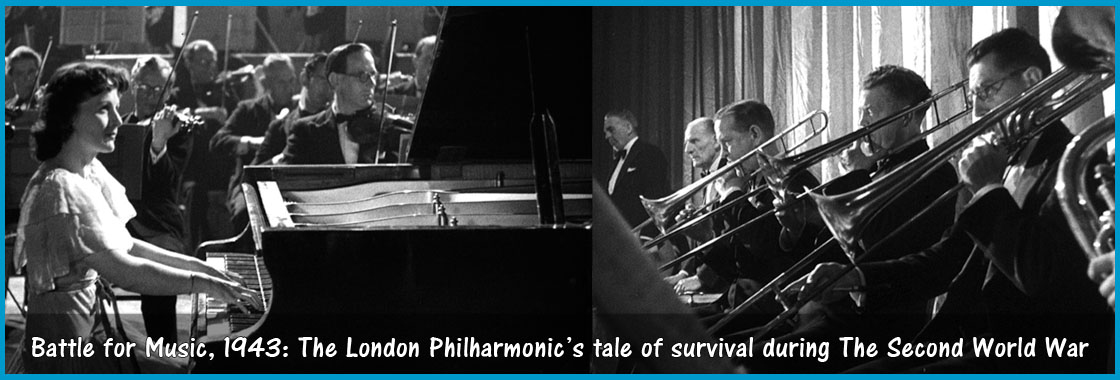The Battle for Music Story
Battle for Music: The London Philharmonic Orchestra at War
Battle For Music : Blu-ray DVD
Over the years I've been involved in many interesting projects researching rare films and documentaries. I first learned about this film from archivist David Meeker who had worked with the British Film Institute.
"Battle for Music" falls into both categories - the fall and rise of the London Philharmonic Orchestra during the Second World War.
As the curtain fell under the shadow of war at the end of a wonderful season at Covent Garden, the London Philharmonic Orchestra faced up to voluntary liquidation.
In this scene a visit to Paris by Thomas Russell to arrange a patriotic concert tour ends abruptly as he flees Paris just ahead of the Nazi invasion: Yellow Princess rehearsal.
The Orchestra was founded by Sir Thomas Beecham in 1932 and performed its first concert at the Queen’s Hall on 7th October of that year. Sir Thomas was Artistic Director and Principal Conductor with the support of well-heeled music-lovers as co-directors, but funding had fallen away as war approached.
At a liquidation meeting held at the Holborn Restaurant in September 1939, a fortnight after the outbreak of war, Beecham explained that there was no funding to pay the players’ fees or creditors, but the players, led by Thomas Russell, pledged to keep the Orchestra together and manage it themselves. With the blessing of Sir Thomas, the musicians formed a new company with themselves as shareholders and elected a Board of Directors. (Beecham does not appear in the re-enactment of the meeting in the film, as he had departed for the United States in 1940.) Viola player Thomas Russell became Secretary and Business Manager of the new company and they resolved to promote the Orchestra themselves and to seek their own engagements.
The idea of making a film about the Orchestra was first mooted by Thomas Russell in 1941, who put J.B. Priestley in touch with Oscar Deutsch, who had founded the Odeon Cinema chain. Priestley agreed to write a script, and Deutsch to finance the production. Both were busy men working on other projects, and they failed to agree on the scale of the production, which Priestley had envisaged as a full-length feature. When Deutsch died in December 1941, the project was shelved.
The story then moves to Autumn 1942 when the Ministry of Information approached the Orchestra suggesting a war-time story with a propaganda slant, and a preliminary treatment was prepared for a short documentary film. Director Donald Taylor of Strand Films, a company with a great deal of experience in war-time documentary production, was put in charge of the project.
After detailed discussions with all parties, at “The little bar of the Cafe Royal, or the Gargoyle Club” a date was set for filming to commence, only for the Ministry of Information to abandon the project thirty-six hours before shooting was to begin. Their excuse was that they could not afford the financial outlay as the film had grown beyond the original scope envisaged.
Fortunately, Donald Taylor, who had become immersed in the project was not going to let “the steamroller of officialdom smash his dream”, and he quickly secured the rights of the script, sought finance, and within a week the project was again in development. It says a great deal for the determination of both Russell and Taylor that Battle for Music was made at all.
After several months of research and false starts, I eventually had what I believed to be the best 35 mm master at the British Film Institute transferred in high defintion, and with some excitement sat down to view the results. It soon became obvious that several scenes were missing from the video screener which the BFI had sent me when I first enquired about the film. To complicate matters further an additional scene had appeared. After reading Thomas Russell's book on the subject, it appears than an early cut of the film was produced but never distributed. Further research at the BFI revealed the theatrically released version which featured one of the missing scenes, where Malcolm Sargent presents a concert for childen in Birmingham. This version was also transferred on 35 mm in high definition, and almost nine months after starting this project, I was able to publish both a DVD and Blu-ray, with both versions of "Battle for Music" and three contemporary shorts.
The film features piano solos by Eileen Joyce playing Greig's Piano Concerto Opus 16 and Ukrainian pianist Benno Moiseiwitsch playing Rachmaninov's Piano Concert No 2, Which was later performed by Eileen Joyce in the 1946 film "Brief Encounter".
